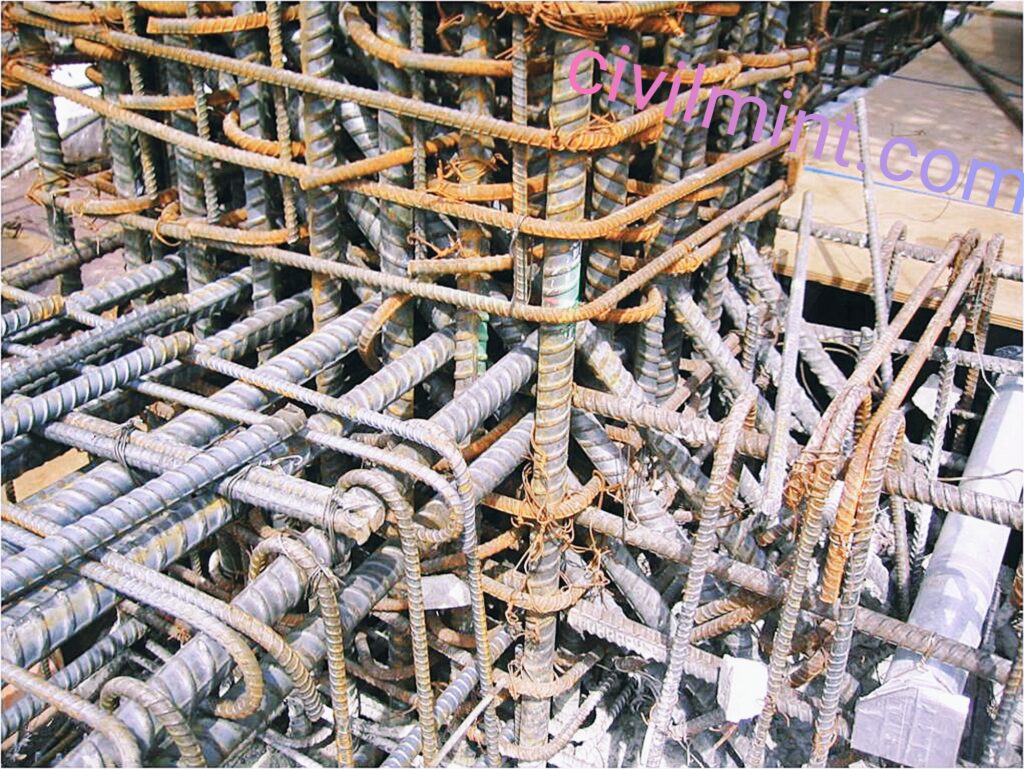In this article, we will talk about how to consolidate concrete in congested reinforced concrete members. The problem of concrete consolidation is occur due to congested reinforcement. In the congested reinforcement, concrete vibrator can not work properly.

Fresh concrete consolidation of contested concrete members should be performed using appropriate concrete pouring and compaction methods. Otherwise, problems such as honeycomb formation and poor concrete cover, in addition to costly and time-consuming repair work, will lead to insufficient strength and reduced durability of concrete elements.
Structural and seismic design requirements, embedded ducts and pipes, and potholes are factors that lead to clogging of concrete structures.
Contractors should take special care and consideration when choosing concrete pouring and consolidation techniques to ensure proper compaction in congested areas and achieve structurally sound and aesthetically pleasing concrete.
It is also important to consider the high fluidity of the concrete and place the concrete in its final position. Finally, proper strengthening of concrete in metropolitan areas requires good detail on the part of the designer and good planning and management on the part of the contractor.
Table of Contents
Various Reasons of Congestion in Reinforced Concrete Members
1. Congestion Due to Steel Reinforcement
Seismic and static requirements cause steel clogging of reinforced concrete elements. Steel jams occur in areas that require additional reinforcement.For example around formed openings, particularly thin wall sections, columns crossing other concrete parts, beam-to-beam connections, deep beams, mat foundations, prestressing elements, bridge deck slabs, etc.
Structural and seismic design requirements result in extensive placement of sleepers on the bottom and top of supports. Closely spaced steel bars hold the coarse aggregate. Concrete covers are therefore made of cement and sand mortar. As a result, concrete covers are susceptible to drying shrinkage, followed by surface cracking and cracking, and eventual loss of durability.
2. Pipes, Ducts and Other Electrical Conduits
Electrical wiring, pipe collars, and other complex structural embedments can interfere with proper placement and strengthening of concrete. Electrical designers commonly specify the use of multiple 25 mm to 150 mm diameter conduits in localized areas for cable trays.
3. Congested Reinforcement for Boxouts
Molded cavities in ceilings and walls are prone to clogging as concrete flow is restricted under cavities and closed openings. Providing construction joints or creating access openings within the recess facilitates correct setting and concreting.
Methods of Concrete Consolidation in Congested Areas
Here are some methods which are widely adopted for concrete compaction in congested areas.
1. Concrete Placement and Compaction Methods
Placing the concrete as close as possible to its final position is essential for proper compaction of the concrete in dense areas. Water injection supervisors or field engineers must use hoppers and chutes for crane and bucket applications.
However, when using a pump to pour concrete, it is recommended that a wire-reinforced rubber hose be connected to the boom’s pipe and poured to near its final position.If the spacing between the bars is too small and the load is too large, he recommends using a flat hose.
This type of pipe runs between closely spaced rebar and allows the concrete to be poured into its final position. The hoses can be cut for easy removal as the ready-mixed concrete rises in the formwork.
In dense wall panels, have an opening on one side of the wall to facilitate proper compaction of the concrete. Ports can be placed on a 0.6 m x 0.6 m grid. When the concrete reaches the first row below the opening, the opening is closed and the vibrator moves to the next upper opening row.A clear plastic panel can be used as a molding surface for limited areas to provide additional visual access. This allows the concrete pouring team to monitor issues during concrete placement and take appropriate action to address them.
Another strategy that can be used to achieve proper compaction in congested areas is the use of internal vibration with unobstructed vertical runs. Vertical strands with a cross section of at least 10 cm x 15 cm can be installed. This allows natural vibrations to occur in confined areas of concrete.The maximum distance between vertical tracks is 61 cm. Where vertical runs cannot be installed without compromising structural integrity, engineers must determine appropriate design details and procedures to achieve proper compaction.
2. Use of Chemical Additives
Addition of chemical additives such as B. Strong water-reducing admixtures improve concrete workability and consequently improve compaction of concrete in urban areas.Chemical additives can increase the fluidity of concrete without affecting the water-to-cement ratio. It should be understood that chemical additives cannot replace the requirement for good compaction due to vibration.
3. Use of Denaturing Mixtures
Corrective mixtures are considered for overfilled concrete elements when the flow of the mixture onto the formwork surface is suspect.The modified mix contains a reduced maximum nominal aggregate size to ensure high concrete flowability.
